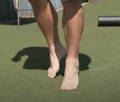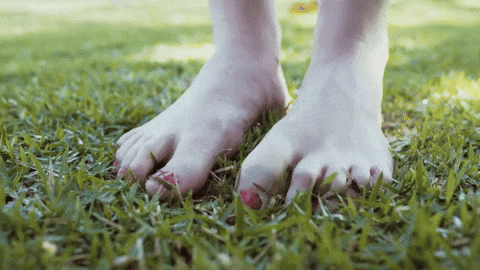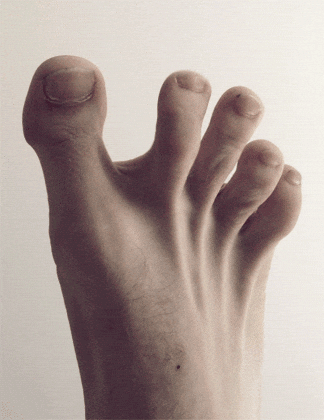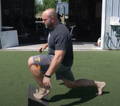Barefoot Training: Good or Bad?
FREE SPEED & POWER WORKOUT!
Download by entering below

Barefoot Training To Unlock Athletic Potential
Acknowledge that athletes in MMA, in the UFC, or are combat athletes, fighting barefoot will occur. With that in mind, a lot of training needs to be done barefoot. Going back to actual performance, Abebe Akila won the marathon at the 1960 Olympics running barefoot because the shoes he was training with were too small, and wasn’t used to training with the smaller shoes; he had to take his shoes off because they were causing tons of blisters. Another example is Tony Franklin, a barefoot kicker in the NFL.
Barefoot athleticism can be used in performance. And again, in a sport like MMA, training should mainly be done barefoot.
So what are the reasons to train barefoot?
Get Rid Of A Sock Tan
This one speaks for itself.

Born To Run
Throughout the book BORN TO RUN by Christopher McDougall, the author discusses how training barefoot improved strength while running, ankle health, stride frequency, and even the ability to traverse hard terrain.
Grounding
A concept that may be a little out there is the concept of grounding or earthing. David Avocado Wolf and the Liver King talks about the benefits of grounding from training barefoot. But most importantly, I believe the foot and ankle get stronger from barefoot training. In turn, when the shoes are put on and an athlete is asked to perform and compete, the barefoot training leads to greater stiffness throughout the ankle joint. A stiffer ankle, not an immobile ankle, allows the ankle to absorb and use more elastic energy. This gives the muscles more bounce.

Proprioception
Training barefoot also leads to greater proprioception and can lead to more coordination through the toes. More coordinated toes give the body a heightened sense of awareness through the toes' interaction with the ground.
Also, as an aside, all the badass farmers I grew up around, huge, hulking PA Dutch dudes, that didn’t give a shit walked around barefoot all day. They never had back problems or posture issues because they were constantly connected to the planet.
Specific Positives Of Barefoot Training
Using toe socks can lead to a positive performance in foot strength, in my opinion.
There is actual research that shows that sprinters who have a more active big toe run faster. More activity in the big toe leads to greater proprioception which leads to better balance and then better posture.
At Ithaca College, Dr. Patrick McKeon has found that barefoot training can lead to better mobility and structural integrity throughout the ankle and foot. This leads to better power output and better posture. And in older populations, the increased proprioception helps in preventing falls.
Best Times For Barefoot Training
I always recommend when walking around the house, inside or outside, do it on your bare feet. Spend 10 to 15 minutes a day walking around the backyard or the sidewalk. It is a great way to play around and feel the toes do what they are supposed to be doing.
We should also be training and walking around barefoot when warming up. It can lead to greater focus, balance, and stability. We can feel the ground come up through the entire body which leads to better posture. In some cases, I even recommend warming up squats barefoot because it carries over to balance. This can be done with both unilateral squats and bilateral squats. Again, barefoot squatting will help with better mobility, and proprioception, and ideally will lead to better performance.
Not Having Shoes On
Not having shoes on will have us lose a larger ground contact area. We will also be a little less stable. Both of these negatives might have an impact on performance in that specific sprint.
Exercise 1: PVC Pipe Walks
Of course, the first exercise to do barefoot is PVC pipe walks. We want to see and feel the toes move, trying to grab the PVC pipe as we walk forward and backward.
Exercise 2: Toe Walks
The movement is simple: walk on your tippy-toes like a ninja trying to not be heard. We want to grab the ground with our toes. A big part of barefoot training is having our toes behave like our fingers. We want to be grabbing the ground and latching on. Sometimes we take for granted the contact gravity puts upon our feet. We have to be active and aware of the tactile sensations perceived through the toes and feet. Barefoot training helps do wonders for such development.
Do this forward and backward as well.
Exercise 3: Heel Walks
Again, the heel walks should be done forward and backward to help the tibialis. We then want to advance the heel walk into a heel step into a roll-up to the toes to stand on our tippy toes. It is a great way to feel the ground contact.

Exercises 4 & 5: Goblet Squats & Bunny Hops
Try to pull the heel out at the bottom of the squat to feel the tension in the glutes. Focus on pulling the heel out at the bottom of the squat. It will help with mobility as well. Do four or five reps and go right into the bunny hops.
With the bunny hops, try to avoid the heel grounding, but the true focus is on being as springy as possible.
Exercise 6: Heel Unsupported Split Squat
A slant board helps to put the heel in an unsupported position. The focus needs to be on stability. Do three to five reps on each foot. Take note of which ankle is weaker and which ankle is stronger.

Exercise 7: LSD Running
The distance running world talks about doing easy LSD work after completing high-intensity endurance work. Spend 15 to 20 minutes doing field crosses on the grass to help alleviate shin splints.
It is basic low-intensity work. For instance, after 1-mile repeats, the endurance runners can finish by doing Xs across the field going forward and backward.
Exercise 8: Low-Intensity Plyometrics
Low-intensity hurdle hops or lower-intensity plyometrics are great for barefoot training. Again, barefoot training with plyometrics leads to greater proprioception and greater joint stiffness.
In a sport like MMA, barefoot mini-hurdle hops lead to better reactive capabilities.
Recap
The historical context of barefoot training and performance helps prove the science and research that speak to the benefits of barefoot training. As icing, we gave some great methods to apply barefoot training exercises to strengthen the toes and create more ankle stiffness for greater elasticity. Give a whirl and cultivate the power in your toes!
Related Posts
Blog Topics

Yo, It's Dane
Welcome to the Garage Strength Blog, where it is my goal to provide you with the experience and knowledge I've gained in the strength and conditioning world over many years of learning from both successes and failures. I train elite-level athletes in a multitude of sports from the high school to professional levels, already producing 5 Olympics and 30+ National Champions. If you want to be the next champion I train, check out my strength programs below!
Start Training With Me

Join for free educational videos EVERY WEEK on strength coaching and athletic performance



